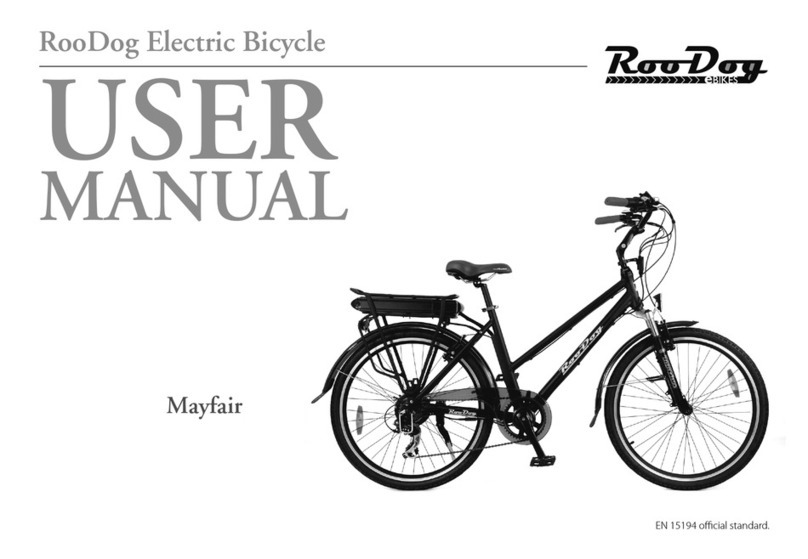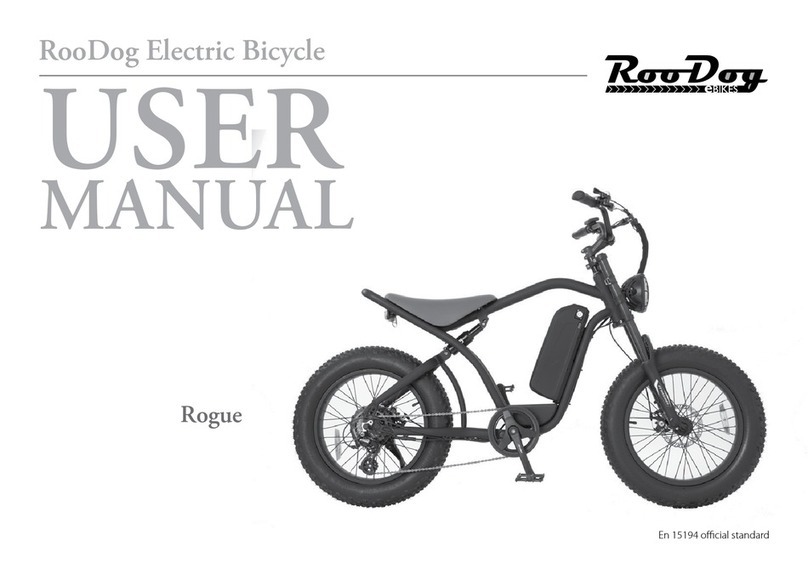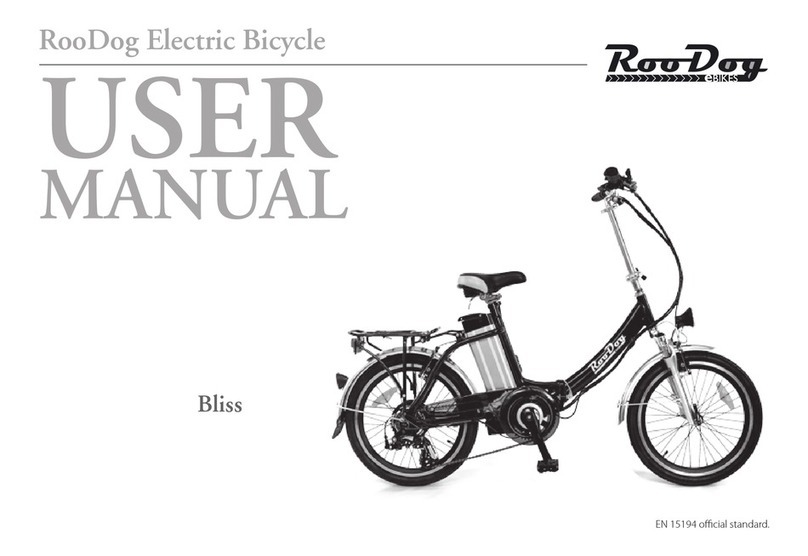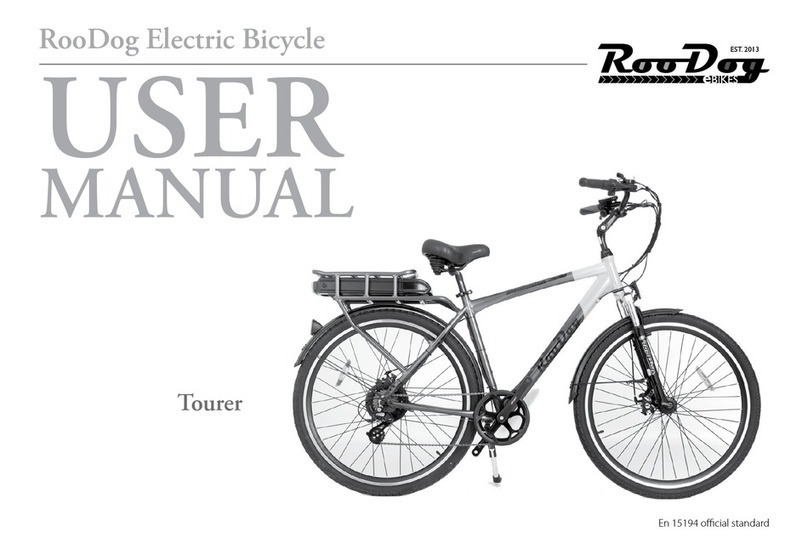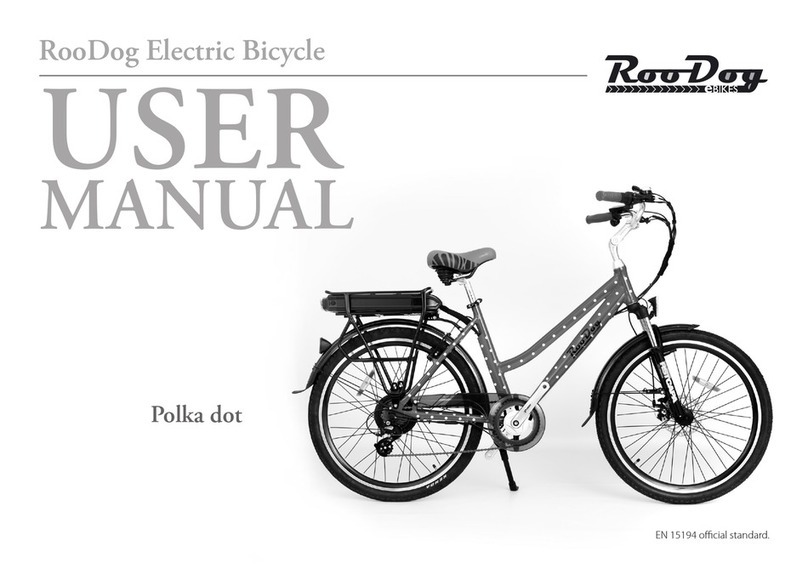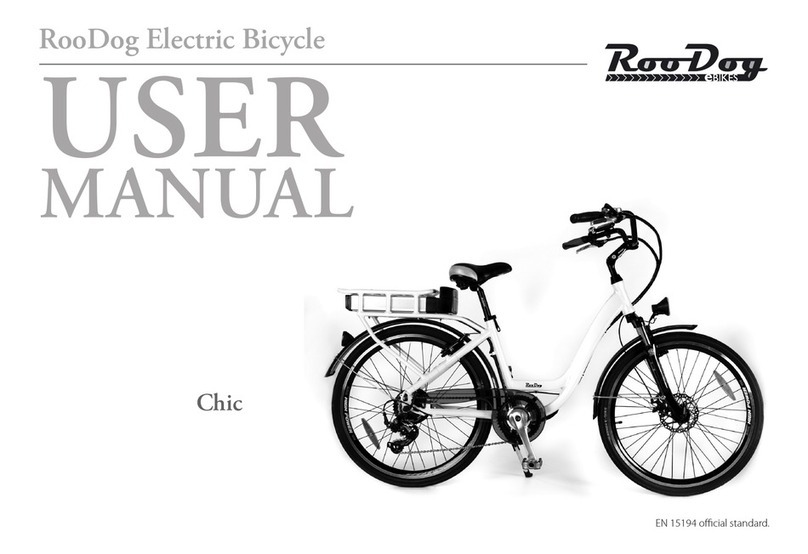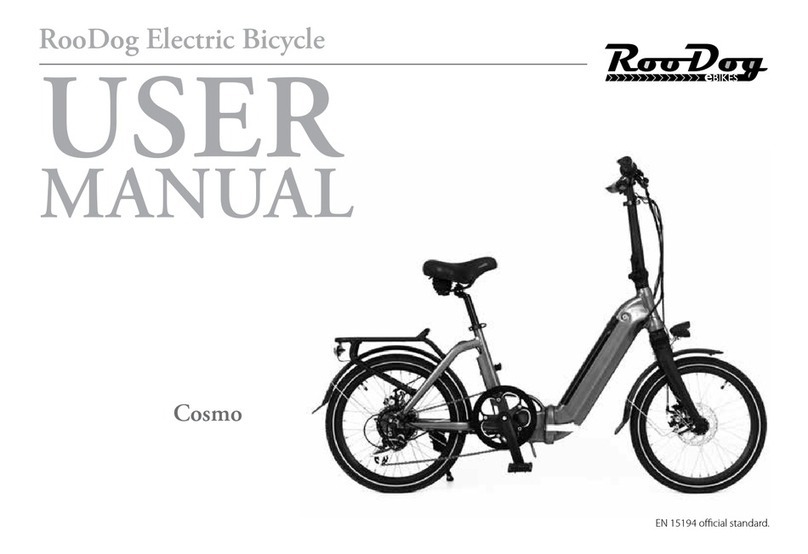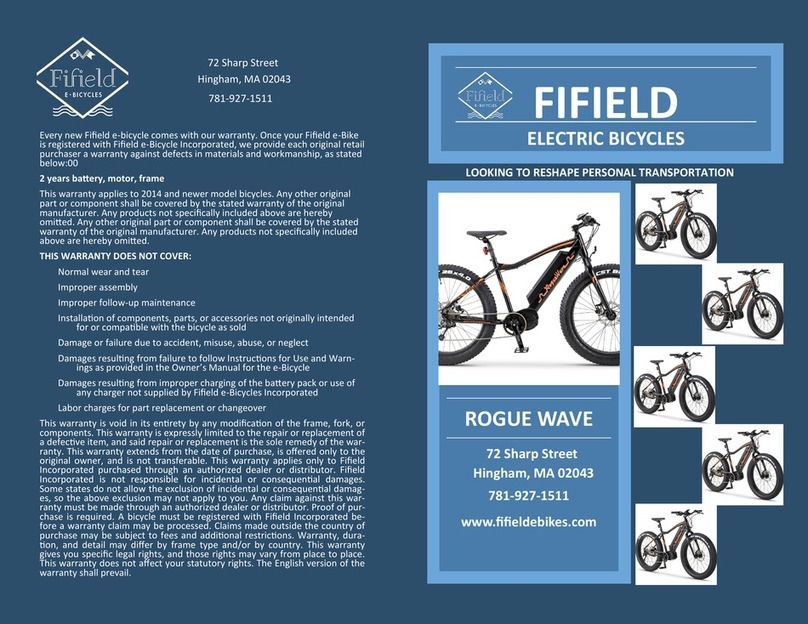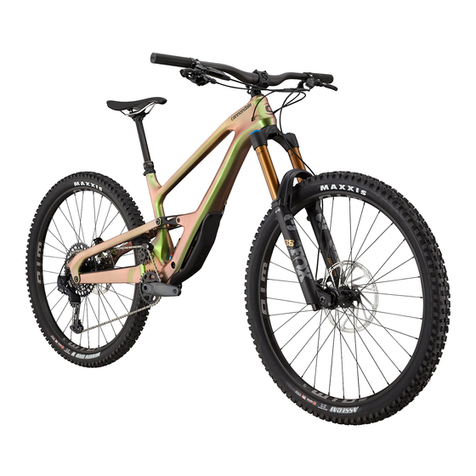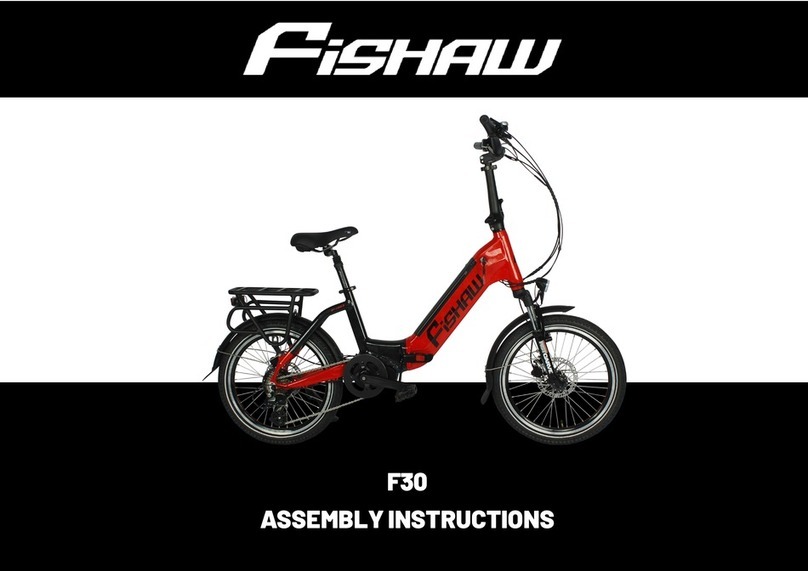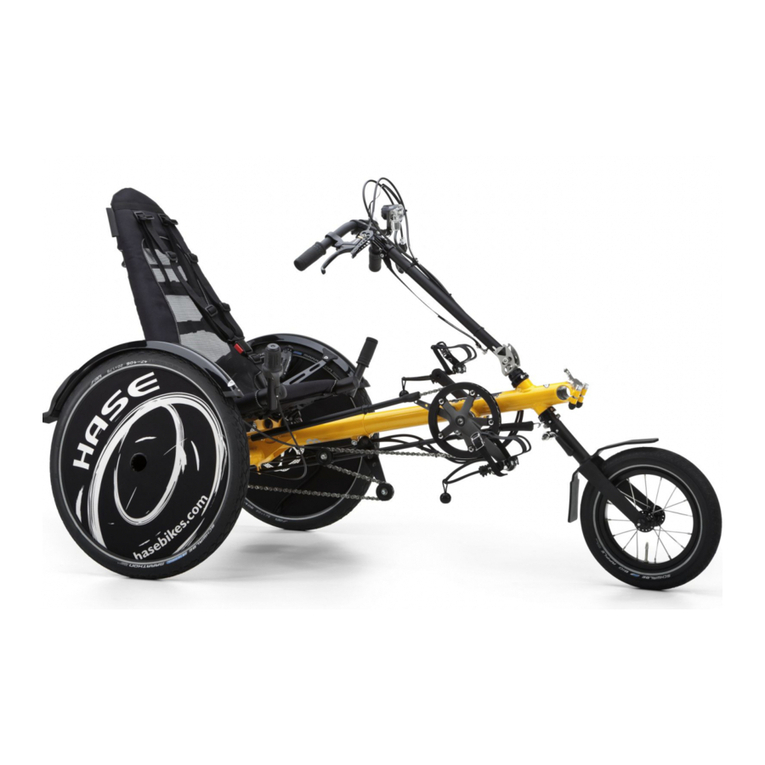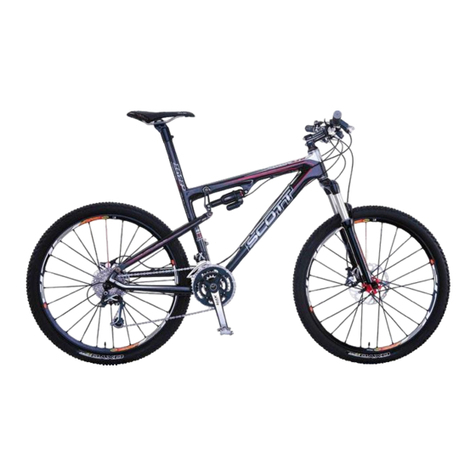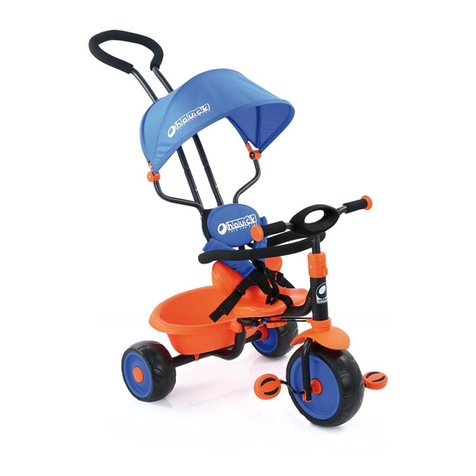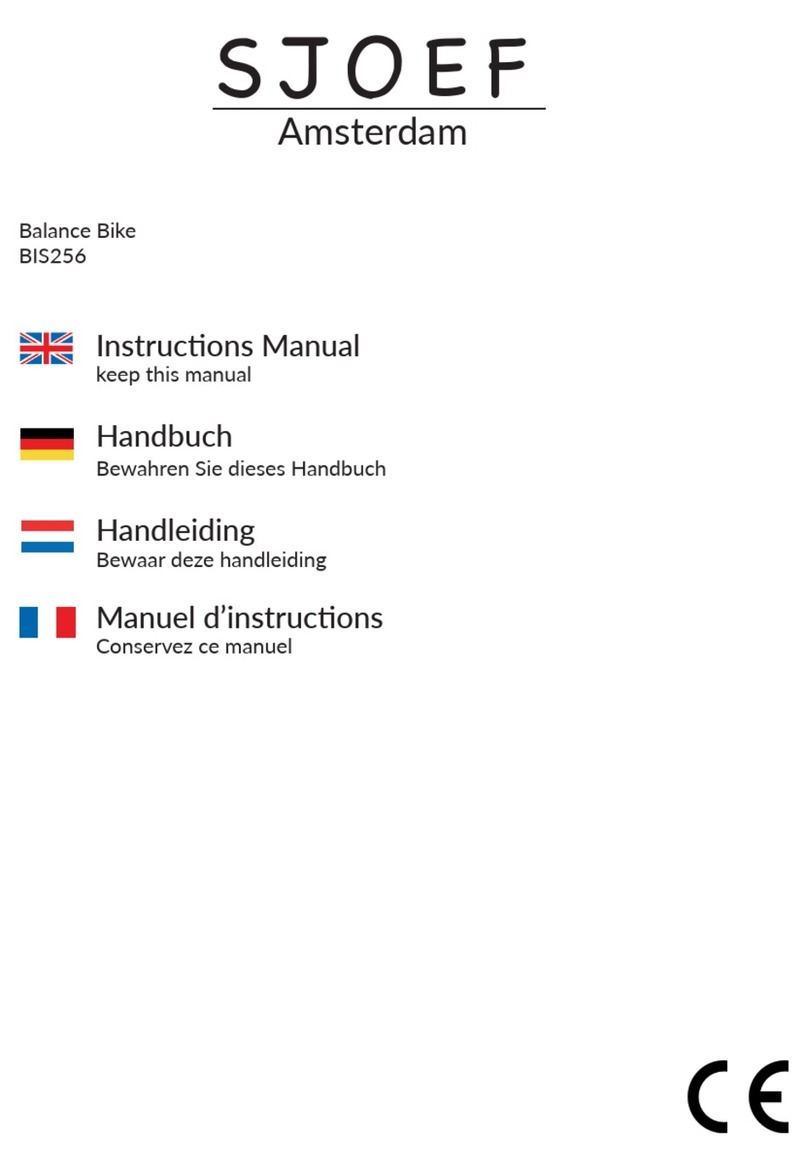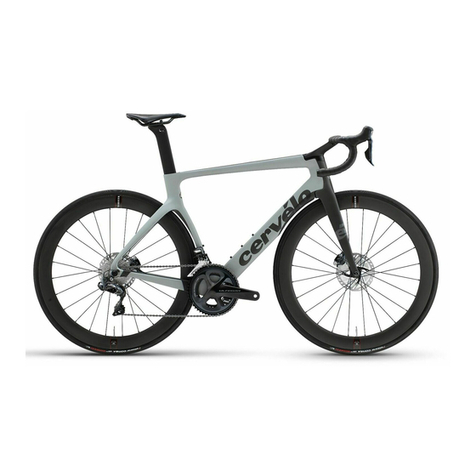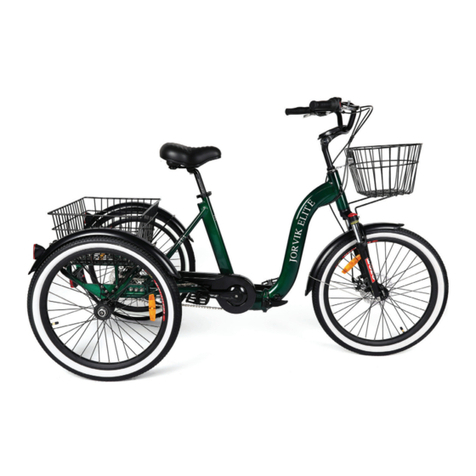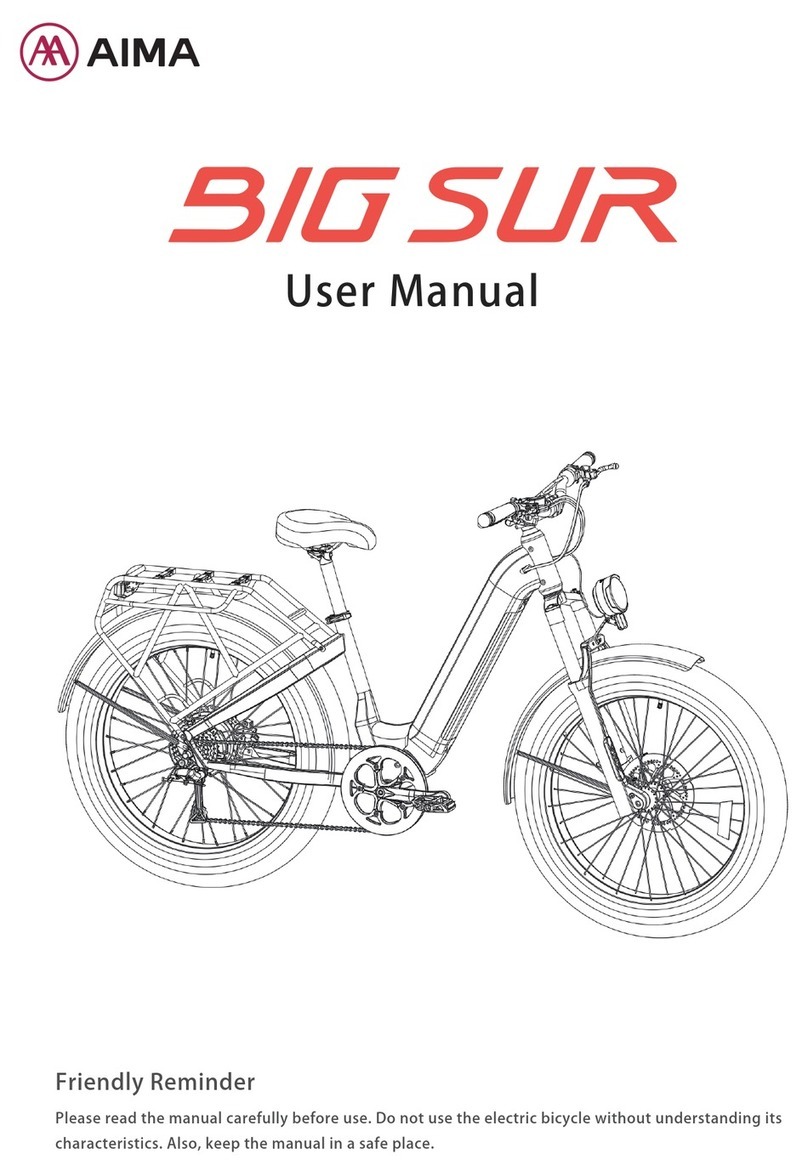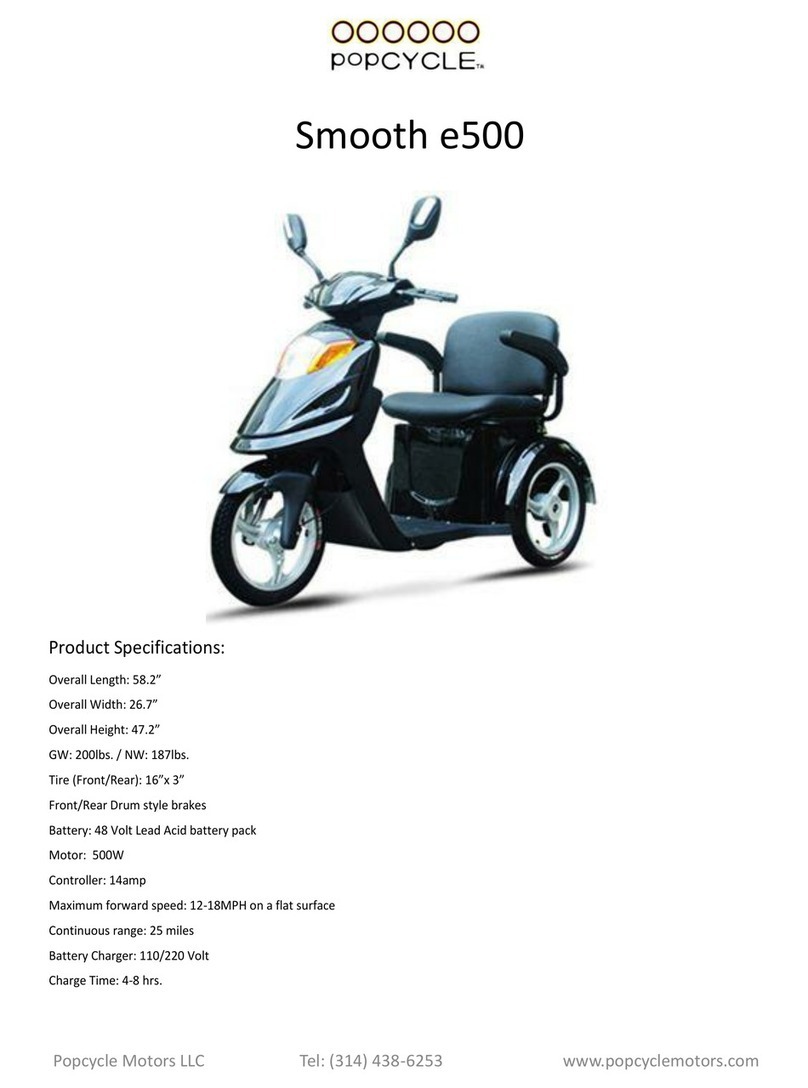RooDog Avatar User manual

RooDog Electric Bicycle
USER
MANUAL
EN 15194 official standard.
Black
Pantone Red 032C
Pantone Blue 072C
Avatar & Avatar ST

2 |www.roodog.co.uk

www.roodog.co.uk |3
Identity:
Frame number:
Date purchased:
Dealer stamp:

4 |www.roodog.co.uk
Thank you for buying a RooDog electric bike. This is one of the best purchases
you will ever make providing it is cared for properly.
Important: Please read this manual carefully before use and follow
instructions provided at all times
For your own safety check brakes, gears, lights and tyre pressures are fully
operational and correct before any bike ride. Also check all fasteners,, quick
release bolts and anything else that may be of hazard prior to setting off.
Important:
Please read & follow battery care guide lines in this booklet before first use.

www.roodog.co.uk |5
Contents
1 x Electric bike, 1 x Battery, 1 x Charger and 1 x User Manual
Index
Parts I.D ......................................................................................................................................................6
Battery Charging and removal....................................................................................................7
Bike assembly...................................................................................................................................... 10
How to use power assistance................................................................................................... 11
King Meter display ........................................................................................................................... 12
Maintenance ....................................................................................................................................... 16
Troubleshooting................................................................................................................................ 18
Warranty................................................................................................................................................. 20
Specifications...................................................................................................................................... 21

6 |www.roodog.co.uk
Parts I.D
We continually strive to give the best products
possible to our customers and therefore parts
are subject to change without notice.
1
12
5
2
64
15
17 16
7
8
9
11
3
10
13
14
1. Saddle
2. Lights
3. Front suspension
4. Front disc brake
5. Rear disc brake
6. Front chain ring
7. Rear 7 speed gears
8. Gear selector
9. LED Display
10. Key Ignition switch
11. Front & rear mudguards
12. Battery cover
13. Battery charge point
14. Bike Frame
15. Pedals
16. Side stand
17. Rear wheel hub motor

www.roodog.co.uk |7
Battery Charging & Removal
Step 1.
Put the silver key in and turn 90 degrees to the right and hold in
that position. Lift up bottom part of the cover until it releases.
Step 3.
Once the cover is removed, undo the Velcro strap then lift up the
top half of the battery about halfway (enough so you can grab
hold of it) Then slide the battery up towards the handlebars. It
should release from the connection point allowing you to then
lift the battery out.
Step 2.
Place hand at the top of the cover & whilst lifting the bottom up
in the air, slide THE COVER down towards the floor. TIP: LUBRICATE
AROUND TOP HALF OF COVER AND BIKE FRAME TO MAKE RELEASE EASIER.
Step 4.
At the bottom of the battery is a connection lead that connects
the battery to the charge point on the side of the bike. If this
is CONNECTED you will have to remove it prior to lift out the
battery. (this is also where you charge the battery when battery
is removed)

8 |www.roodog.co.uk
Battery Charging & Removal Continued
Replacement
Step 1.
Replace the connection lead for the charge point on the side of the bike (see step 4 on previous page) then
place the bottom half of the battery in first, making sure the connection prongs line up correctly. Slide it
down so the prongs fit inside of the battery then drop the top of the battery in. Don’t worry if it doesn’t sit
level at first just simple press the bottom of the battery down until it does. Then re-strap the Velcro together
to hold the battery in position.

www.roodog.co.uk |9
Step 2
Replace the connection lead for the charge point on the
side of the bike (see step 4 on previous page) then place the
bottom half of the battery in first, making sure the connection
prongs line up correctly. Slide it down so the prongs fit inside
of the battery then drop the top of the battery in. Don’t worry
if it doesn’t sit level at first just simple press the bottom of the
battery down until it does. Then re-strap the Velcro together to
hold the battery in position.
Step 3
Place hand at the bottom of the cover and press firmly down
until you here the lock click.
Battery Charging & Removal Continued
Replacement

10 |www.roodog.co.uk
Bike Assembly:
Tools Required: 4 and 5 mm Allen keys, 10 and 15 mm spanners
›Remove all packaging carefully: and select a good area to
assemble the bike. Preferably on a non abrasive surface so you
don’t damage the bike.
›Easier with two people: Have someone hold the bike
upright for you. Then remove the bolt on the arch of the
front suspension fork using the 10mm spanner and the 5
mm Allen key.
›Front Light: Assemble the front light (you will find this in your
accessories pack) Place the front light bracket over the bolt hole
and replace the bolt fully but do not put the nut back on. Then
fit the two small wires to the light assembly by simply pushing
them on to the metal spades.
›Front mudguard: On the back of the fork arch hang the loop of
the front mudguard over the bolt and then replace the 10mm
nut and tighten with the spanner and Allen key.
›Handle bars: Remove all the 4/5mm handle bar bolts and
bracket at the end of the stem, place handle bars in position
then replace the bracket and bolts, tightening with fingers
first. Once all 4 bolts are situated correctly you can tighten with
the 4/5mm Allen key but do this from corner to corner and
only a little bit at a time on each to keep the bracket even. For
example: tighten top right corner bolt first, then bottom left
corner bolt second and so on.
›Front wheel: Place bike in a bike maintenance stand or turn up
side down so the bike is standing on the handlebars and saddle
but again try to do this on a non abrasive surface to avoid
damage. (remove battery first in order to lighten and make it
easier to maneuver the bike) Once in position take the front
wheel and the quick release skewer/axle bolt. Undo the plastic
end cap and take off one spring (leaving one spring on). Slide
the bolt through the Centre of the front wheel until it comes
out the other side, then place the spring back on first (small end
first) followed by the plastic end cap and loosely tighten. Prior to
inserting wheel make sure the tyre will be spinning in the right
direction (see tyre sidewall). Pick the wheel up and slide into the
slots provided on the front fork and push downwards until it
stops. Once aligned you can tighten up the skewer bolt. (lever
should point upward when fitted correctly)
›Disc brake: If not already correct adjust brake by releasing
brake cable with 5mm Allen key then adjust accordingly and re-
tighten. Spin the wheel to make sure it spin freely. You can make
minor adjustments by turning the plastic screw located on the
brake cable near the brake caliper.
Note: Your wheel should fully stop once the brake lever
is depressed halfway. If it does not stop, re-adjust them
accordingly.

www.roodog.co.uk |11
Getting Started and how to use your power assistance:
Twist to operate
Mode
Up / Down
Isolation button to turn throttle
on/off.
1. Once your bike has been safety checked and is ready to ride the next step is to turn on
the electric.
2. Press and hold the mode button on the left handlebars to turn on the LCD display.
3. Once turned on it will automatically select the lowest level of pedal assist. For full
instructions see LCD user manual on the next page.
4. At this point if you start to ride the bike the PAS assistance will automatically kick in and
assist you whist pedaling. (Tip: stay on the lowest level until you become confident
enough to increase the power) You can increase the level of assistance simply by
pressing the up button, this will be indicated by the number on the display. 1 being
the lowest level and 5 being the highest maximum assistance. (15.5 M.P.H) IMPORTANT:
Please be aware that the assistance is also sensitive to how fast you pedal and will only
give you maximum assist when you are pedaling relatively fast. (this applies in most
levels selected)
5. To turn off the assistance so you are only using manual pedaling either press the mode
button to turn off completely or press the down button so that the assists level shows 0.
6. On the right hand side of the handlebars you will find (if fitted) a half twist grip throttle.
When the bike is turned on, the throttle is active and operates independently of
pedaling, a bit like a moped. (no requirement to pedal) Please note the red isolation
button also needs to be in the depressed position for the throttle to be on.
7. Simply twist the half grip throttle and it will propel the bike up to 4mph. On the 1st of
January 2016 the UK fell in line with the EU regulation and adhered to the capping of
throttle speeds to 4mph. Which all our e-bikes adhere to. Beyond this the PAS will take
you up to 15.5mph.
IMPORTANT: When using the throttle try to avoid hill starts and only use pedaling
when the bike seems under strain to avoid motor burnout. In not doing this it can also
void your warranty.

12 |www.roodog.co.uk
KING- METER
USER GUIDE
SW-LCD

www.roodog.co.uk |13
Display:

14 |www.roodog.co.uk
Display Description:
Display Function Description
Speed Speed, display unit by MPH
ODO/TRIP
ODO for accumulative mileage
TRIP for single mileage
Switch by function keys
Battery indicator Residual electricity display
Cruise identification Display, for cruise state
PAS instruction 0-5 display of 5 speed PAS
Error code display See error code chart
Turn on / off Turns display and PAS on and off
Up and down Controls level of PAS and display functions

www.roodog.co.uk |15
Display Description Continued:
Press and hold mode button yo turn on and off
Power off resets trip
When on press once to change ODO/TRIP
When on hold button down to turn lights on/off
Hold both to bring up setting. Press mode to change tho the next setting.
Hold mode to reset to man screen
Hold up and mode to change speed
Hold up for walk assist function
Hold all 3 buttons down to enable USB port function
Error Code Display: If there is something wrong with the electronic control system, the display will show the error code
automatically. The following is the definition of the error code.
Code Number Definition Code Number Definition
21 Abnormal Current 24 Motor Hall Defect
22 Throttle Fault 25 Brake Failed
23 Motor Phase Problem 30 Abnormal Communication

16 |www.roodog.co.uk
Maintenance:
Maintaining your bike ensures you will get the most out of every
ride and increases the longevity of your RooDog electric bike.
How much you can do your self really depends on your skill,
knowledge, experience level and if you have the necessary tools
for the job.
If there is is anything you do not understand or are unsure
of how certain things work it is always best to contact your
RooDog dealer for advice.
Disclaimer:… Please be aware general maintenance is not
covered by the warranty and is therefore a service that will be
chargeable.
Before every ride:
›Check brakes, Lights, gears and tyre pressures are correct.
›Check fasteners, bolts and anything else that may come loose
over time.
›Check battery is fully charged, or at least has enough charge to
complete your planned journey.
Weekly:
›Clean the bike, including chainring and gears – (do not use
excessive water around electrical parts)
›Oil the chain, and keep all moving parts well lubricated and free
from damp.
Every month:
›Check for worn brake pads and replace if necessary.
›Check headset for looseness by rocking the bike back and
forth whilst having the brakes applied. If loose have your
dealer check it.
›Check free movement of handlebar. If tight have deal check it.
›Check cables for free movement, rust, kinks and fraying.
Replace if necessary
›Check wheel spokes are all tighjt and wheel spins true. Have
your dealer fix it if they are not. (spokes can break and wheel
rims can be bent if this is not regularly checked)
›Check tyre for tread and check sidewalls are in good condition.
Replace if necessary.
Every 3000 miles or annually:
›Have the bike inspected and serviced at your local dealer
including general inspection of the hub motor and all
electrical parts.

www.roodog.co.uk |17
Maintenance Continued:
Tyre pressures:
›Tyre should be routinely checked for correct pressure. (this is
stated on the tyre side wall). Failure to do this will result in tyre
or rim damage, more energy will be required to propel the
bike (meaning less miles per charge) and possibly may even
result in a puncture.
Repairing a puncture:
›If you have a puncture we recommend you have it repaired by
a specialist.
›To remove the rear wheel you must first separate the electric
hub motor from the bike. In order to do this, locate the cable
coming out of the hub motor and follow it along to the quick
release (QR) plug. Disconnect the plug and all clips and ties
before attempting to remove the rear wheel.
›Prior to removing the wheel from the frame take note how
all the washers are situated so you can replace them in the
correct order in which they came off.
›When replacing the wheel back in the frame, ensure the bolts
are aligned correctly (you may need a 10mm spanner to
help) and seated right and all washers are in correctly before
tightening up the nuts to hold it in position.
›Finally reconnect the motor plug fully so the clip clicks in.
(incorrectly replaced in may result in a sudden lose of power
or may even damage the contacts connecting the motor)
Motor QR plug:
Press here to release
then pull apart.

18 |www.roodog.co.uk
Troubleshooting
Problem Possible Causes Solution
Power on but motor not
working:
›Motor not connected correctly.
›Rotation disc damaged or not close enough to
sensor.
›Brake lever is pulled in triggering the cut off sensor.
›Loose connection or controller fault.
›Check connection plug is pushed
together fully.
›Clean and push closer if needed.
Contact dealer if damaged.
›Make sure both brake levers are fully out
not triggering the sensor.
›Contact your dealer.
No Power at all: ›Uncharged or dead battery.
›Key not turned on.
›Faulty switch or loose connection somewhere. i.e
the LED display.
›Faulty controller
›Recharge the battery and try again. If
problem remains then contact your
dealer.
›Check the key is on position
›Check the connections of the LED
display, the motor and the battery.
›Contact your dealer.
Traveling shorter distances per
charge than rated:
›Hill climbing, frequent stop/starting, head wind or
heavy load, excessive use of throttle.
›Tyre pressures too low.
›Battery under charged or faulty charger.
›Battery capacity loss or damage
›Use 1.1 pedal assist and pedal harder.
Reduce the use of throttle and lighten
the load when ever possible.
›Inflate tyre to correct amount indicated
on tyre sidewall.
›Charge the battery or contact dealer.
›Contact dealer to inspect.

Troubleshooting Continued:
Problem Possible Causes Solution
Charging:
Charger light stays green
when I plug in to the battery.
Why? (the light should turn
red to indicate the battery is
charging and green when it
is full)
›Battery is already full.
›Charger lead not connected to the battery properly
›Fault with the charger.
›The battery has gone in to sleep mode due to not
been charged to protect the cells.
›Drain some power by riding the bike
and then retry charging.
›Check the connection.
›Contact Dealer.
›Contact Dealer.
Charger doesn’t work: ›Fuse has blown.
›Has been damaged through misuse.
›Change fuse and retry.
›Contact dealer.
Important:
Always use the charger supplied by the manufacturer to avoid damaging your battery

20 |www.roodog.co.uk
Warranty:
Requirements for warranty:
›Please retain your receipt as proof of purchase as this is your
warranty and warranty will start from the date of purchase.
›Warranty is non transferable and only applies to original owner.
›Warranty covers – main bike frame, front forks, mud guards,
wheel rims, gears, bearings, motor casing and hub motor, LED
controller display, brakes (excluding brake pads), battery and
charger.
Items covered by 2 year warranty:
›Battery (provided cared for in conjunction with battery care
instructions)
›Motor casing & Hub Motor
›Bike frame
All other parts covered by the warranty are guaranteed
for a period of 12 months
Exclusions from warranty:
›When subject to neglect or misuse or resulting in damage due
to an accident.
›Poor maintenance or modifications that no longer complies
with regulations or original technical specifications.
›Damage due to external causes such as left out in heavy rain, or
long term weathering causing rust and decay etc.
›The bike is put up for hire.
›The Battery is used incorrectly or tampered with (warranty seal
is broken). This also applies to charging. (always use the charger
provided by the manufacturer)
›Battery is not cared for in conjunction with the battery care
instructions provided.
Items not covered:
Brake pads, tyres, lights and cables or anything else that can be seen as consumables. These parts can however be purchased
from RooDog Ltd or from your local Retailer/bike shop.
This manual suits for next models
1
Table of contents
Other RooDog Bicycle manuals
